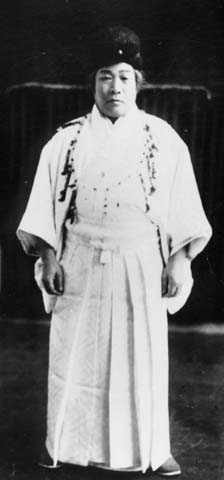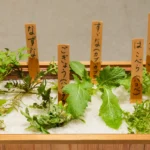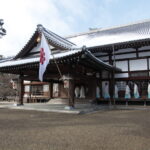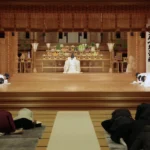By Ruth Reiner
Hello and welcome to my second summary and review of the fantastic book “The Great Onisaburo Deguchi”, written by Kyotaro Deguchi. I hope you will enjoy it.
As some fantastic stories begin, also this book written by Kyotaro Deguchi starts with a never failing sentence: “Long ago, in an area slightly to the west of the center of Japan, there were two large lakes called Omi no Umi and Ni no Umi”. “Omi no Umi”’ is known today as lake Biwa, and is the largest lake in Japan. “Ni no Umi” has completely dried out and no longer exists, but the area is called Kuchi-Tamba. At the center of Kuchi-Tamba is the Kameoka Basin separated by mountains from Kyoto to the east.
Onisaburo Deguchi (Kisaburo was his original name), the co-founder of Oomoto, was born on August 22, 1871, in “Anao”. Anao is one of the villages scattered across this basin. Onisaburo was born in the midst of a difficult period of transition from the old feudal rule to the new Meiji government. As Kyotaro Deguchi writes, “It can be seen quite ironic that Onisaburo, who spent all his life in conflict between divine and imperial rule, was born in the time that Kameoka was still ruled by dual administrations”. (chapter 1)

Before World War 2 in Japan, one often heard the words ”loyal subject” and “traitor”. To be called a traitor back than, was to carry a very bad stigma. There have been many “traitors” in Japanese history, but “at the time before the war there were four considered by Japanese to be The Greatest Traitors of all: “:
Yuge no Dyoko (d. 772) a Buddhist priest of the late Nara period, who rose to the position of prime minister and attempted to usurp the imperial throne.
Takauji Ashikaga (1305-1358) rebelled against the imperial court and reestablished military rule as the first shogun of the Muromachi period.
Mitsuhide Akechi (1526-1582) a feudal lord who turned against his overlord Nobunaga Oda.
Onisaburo Deguchi? well, many designated him the greatest monster since the beginning of Japanese history. Only a few understood what kind of man he was. Onisaburo was a figure that caused a nationwide furor and was a model of active rebellion in the first half of the century.
But was he a traitor? (ch. 1)
As Kyotaro Deguchi said that from an overview of it’s landscape the Kameoka basin is a quiet and peaceful scene, I could agree on that from my experience here. However, “One is driven to wonder whether there is some eerie, magic power”, having had a persisting tradition of rebellion: three of the four “traitors” mentioned above had a direct relationship with the Kameoka Basin.
Although Onisaburo disclaimed any connection with royal ancestry, the Ueda’s family’s ancestors were in fact called Fujiwara, (a name of an important aristocratic family of the Heian period (794-1192)). However, by the time Onisaburo was born, all there was left was one poor farmers’ hovel. The family had reached it’s lowest point, due to a succession of profligate sons.
Kichimatsu, Onisaburo’s grandfather, got the family into even greater depths with his addiction to gambling. In Onisaburo’s diary, we can learn of his grandfather’s attitude to this situation, when answering his wife’s, Onisaburo’s grandmother’s concerns: “Don’t worry… out of one thousand people one or two die of starvation. The other nine hundred and ninety-nine all die of overeating.” (ch. 2)
Not long after Onisaburo was born, his grandfather Kichimatsu passed away. The dying fifty-eight year old Kichimatsu called to his bedside his son and son’s wife and pronounced:
”From long ago in the Ueda family, every seventh generation produced a great man who makes a mark in the world… my grandson is seven generations after Okyo Maruyama (1733-1795, a very famous painter), and he will certainly make a name for himself in some way… A fortune teller in Kameoka… said that he is a most unusual child, and that we should bring him up carefully… after I am gone my spirit will guide him.” (ch. 2)
It is also said that just before he passed away, he sang a song about how he had given himself to gambling all his life and how he intended to go right on doing the same in the next world.
On January 4, 1874, Kisaburo’s younger brother was born. Yone, Kisaburo’s mother then put Kisaburo in the care of his grandmother Uno. Uno was quite an unusual erudite woman herself, versed not only in Japanese poetry, but also in the esoteric science of kototama.
“Kototama is the name given to the mysterious power of the spoken word. In ancient times in Japan there was no written language, and traditions were transmitted from generation to generation orally. Thus the spoken word was regarded as extremely precious, and was believed to have its own spirit. The mysterious spiritual power of the vowels and consonants was believed to bring about certain phenomena, a field in which research is still being carried on today.” (ch. 2)
Uno was born into the family of the nineteenth century scholar Kodo Nakamura, who lived near Kameoka, the author of a book entitled “A Study of Kototama in the Japanese language”. Uno had a great influence on the young Kisaburo.
At the age of four, Kisaburo suffered a serious disease of the digestive system, and again by the age of six he was struck with a terrible illness. Due to his illnesses Kisaburo was late in starting school, and it was from his grandmother that he received his first lessons in reading and writing.
“Some of Onisaburo’s childhood friends while asked about him, have a positive memory of him and yet at the same time recall him as being a “day-dreamer” and that sometimes they could not tell if he was a fool or a genius.” (ch. 2) In Onisaburo’s collection of autobiographical poems, we can find some stories relating to Onisaburo’s childhood. One of the more amusing ones, is how Kisaburo nearly burned his house down. This story and more you will find on next week’s item on “The Great Onisaburo Deguchi”.



